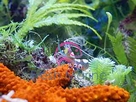Peppermint Shrimp

Peppermint Shrimp
Taxonomy:
Peppermint Shrimp belongs to the Kingdom Animalia, Phylum Arthropoda, Class Crustacea, Order Decapoda, Family Hippolytidae, Genus Lysmata and Species wurdemanni.
Other common names:
Peppermint Shrimp is also commonly known as Candy Cane Shrimp, Caribbean Cleaner Shrimp and Veined Shrimp.
Origin or natural range:
Peppermint Shrimp originates from the Indo-Pacific region including Caribbean, Florida and East Atlantic.
Size:
Peppermint Shrimp grows up to a size of around two inches or five centimeters.
Color:
Peppermint Shrimp occurs in cream, red and white colors.
Compatibility:
Peppermint Shrimp is semi-aggressive towards the marine aquarium members. However, it is aggressive towards some species of shrimps, especially Coral Banded Shrimp.
Habit & Habitat:
Peppermint Shrimp is nocturnal in nature and therefore, hides out during the day time behind rocks, overhangs or rock caves, whereas it actively feeds at night.
Morphology:
Growth enabling environment in your marine aquarium:
Care:
Caution:
Peppermint Shrimp may nip corals and clams in your marine aquarium. Therefore, it's better to keep Peppermint Shrimp in a fish only marine aquarium rather than in a reef type marine aquarium.

Cleaner Shrimp - Lysmata amboinensis - Cleaner Red Skunk Shrimp - White-Striped Cleaner Shrimp
Freshmarine: $29.98
You Save 23.11%
Fire Shrimp - Lysmata debelius - Scarlet Cleaner Shrimp - Blood Shrimp - Fire Shrimp
Freshmarine: $43.98
You Save 37.16%
Glass Anemone Shrimp - Periclimenes brevicarpalis - Pacific Clown Anemone Shrimp
Freshmarine: $19.95
You Save 31.18%
Before Placing Your Order
Store InformationShipping Info
Payment Info
Return Policy
Arrive Alive Guarantee
Adoptation Policy
After Placing Your Order
Track Your OrderSecurity Safe Shopping
Compatibility Chart
Shoppers Review










